Today it has become popular to create stunning and unique landscape design and landscape compositions on their backyards, that would set him apart from the rest. For this purpose, there are various ornamental plants, among which the special role played by coniferous culture. That these plants are valued by gardeners for their magnificent appearance and decorative all year round.
Especially often in the household plots you can find a fir, which perfectly fits into any composition. There are a large number of varieties of this plant, for example, a spruce of Daisy White - a beautiful and tender conifer plant, landing and care for which will not be difficult for even the novice gardener.
In this article, we consider the features and description of the ate of Canadian Daisy White, as well as the use of this kind of coniferous plant in landscape design. We note the important rules for landing and care for the fir Daisy White.
Features and Morphological Description Spruce Daisy White
Spruce or from Latin Picea is the genus of evergreen coniferous trees, which belong to the large family of pine. There was a general name of the genus from the Latin word "PIX", which in the translation denotes "resin". Explain such the origin of the name of the culture is quite simple, because the plants of this kind are distinguished by a large number of resins. To date, there are about 40 different varieties in the family of fir, among which the fir of Canadian or glaucms are particularly popular.
Spruce Canadian Daisy White is a bright and original variety, which was derived from a well-known variety of horseback ate, as evidenced by the overall features of the appearance and crown. This is a relatively young sort of ate, which was led in 1996 in Belgium during the mutation ate of a horse. Fir Daisy White or Daisy's White is a motley and miniature coniferous plant that fits perfectly into any landscape composition. This variety was obtained due to creamy-white growths during flowering.
Description Spruce Daisy White:
- Fir Daisy White is a unique dwarfgy pattern of a coniferous plant, which has gained widespread among gardeners and landscape designers and is considered one of the youngest and beautiful varieties of Canadian ate.
- The first decade in the ate of this variety the root system is represented by a rod long root, which in time deviates. After that, the plant is attached to the soil with small surface roots, so it is important to plant the culture in the places protected from strong wind.
- In the height of a dwarf variety of ate Daisy White can reach with an average of 80-100 cm, the coniferous tree can grow up to about 2 meters.
- The shape of the crown of this variety resembles the crown of the fir drill and is the correct cone.
- The tree grows very slowly, by 10 years can reach only 80 cm. At the same time, a plant can be added in just 2-3 cm. An adult coniferous plant of Daisy White variety in diameter is maximum 1 meter.
- The crown of the plant is formed by short and soft shoots that are very tightly adjacent to each other and thereby do not let sunlight and do not create lumets. This allows the ate of Daisy White to form a very beautiful and neat crown, through which the trunk is not visible.
- This variety ate is very decorative, since her needles change his shade throughout the season. Basically it is bright green. Then during flowering in about May-June, a young increase acquires a yellowish-white color. Later, this increase is greasy.
- Soothes are thickly covered with soft needles. It is important to take into account that in the spring whitish growths can burn in the sun, so it is recommended to construct the shelter.
- Spruce Canadian Daisy White is a plant light-affilome and unpretentious, perfectly coming up in any climatic conditions.
- This type of coniferous plant is considered a frost-resistant tree, which belongs to the climatic zone 4, so the fir of Daisy White withstands frost to minus 35 degrees. However, it is worth not to forget to stream young plants in the spring so that they are not injured from spring return freezers.
Using ate Daisy White in Garden Landscape Design
Coniferous plants are found in almost every professional landscape design and garden composition, since these plants are harmoniously combined with various cultures. Spruce Canadian Daisy White is a very decorative tree that can be used in decorating and landscaping a household plot in various versions.
- First of all it is worth noting that Spruce Daisy White is an excellent soliter. Singing single Christmas trees of this variety can be on the background of lawn or in the heather garden. In addition, thanks to a small increase, such coniferous trees will perfectly fit near the terrace or arbors, on both sides of the steps.
- Beautifully look at the ate of Daisy White along the garden tracks or borders, as well as in the frame of garden benches.
- Many gardeners plant seedlings of this variety ate in combination with other coniferous plants of low growth, thereby forming unusual and spectacular garden compositions.
- Ew glaucca Daisy White fits perfectly in mountaineering and mixlers in combination with perennial herbaceous plants and flowers.
- Such compact Christmas trees can be grown in garden pots and containers, they are excellent for small country sites.
Spruce Daisy White is a bright and spectacular variety, which in recent years is very popular with gardeners. After all, due to its decorativeness, can fit into any composition. Each landscape designer and gardener can choose the most optimal version of this plant for it. Below are photos of ate Daisy White in the landscape.
Reproduction Spruce Daisy White: The most common ways
The cultivation of Eloi Canadian Daisy White does not represent special difficulties and is practically no different from landing and care for other types of coniferous crops. First of all, it is necessary to know the main methods of reproduction of this plant, which will further depend on the growth and development of ate. This variety at home can be multiplied by two basic methods: seeds and stalling. There is another option - it is to use the method of vaccinations, but for inexperienced gardeners it will seem quite complicated. Consider the features of the most common breeding options ate Daisy White.
Seed reproduction
- This method of reproduction is considered the longest, but if you have a hurry to have nowhere, you can try to grow fir Daisy White from seeds. With this method, you can immediately get a large number of seedlings of a coniferous plant.
- The planting material for this method of reproduction can be purchased in specialized garden centers or to assemble from an adult tree ate Daisy White. To do this, wait for the full ripening of cones and collect seeds from them. It is necessary to do it in the period until the bumps revealed. To facilitate the extraction of planting material, the cones must first dry.
- Experienced gardeners are recommended to strateb seeds ate Daisy White to speed up further germination. For this, the prepared seeds are placed in the soil mixture consisting of sand and peat, after which they put in the refrigerator for about 2 months.
- At the end of winter or at the beginning of the spring, prepare a suitable container with soil mixture consisting of a delicate deciduous soil, peat and sand.
- The soil is watered, after which he sowed the seeds of ate, blocking them as 1 cm.
- Next, the container with crops must be put into a warm and bright room, for example, on the windowsill.
- Further care for seedlings is regular watering. When the sprouts are slightly growing, the amount and intensity of the irrigation is reduced.
- If the seeds are planted densely, then in the future seedlings need to dive.
- At a permanent place to open soil seedlings, Atei Daisy White are planted for the second year, it is recommended to land at once in place where the plant will be constantly, as a frequent transplant harms young plants.
- It is worth remembering that seedlings of seeds grow very slowly and they need regular care.
Pencornia reproduction
- This method of reproduction is also sufficiently long and time consuming, but it allows you to get a large number of seedlings at the same time.
- This method is carried out in spring time until the kidneys appear on the trees.
- On the ate of Daisy White, you need to cut strong and young shoots with a length of about 6-10 cm.
- Next, the cuttings are recommended to lower the sections to the solution of growth stimulator for a couple of hours to speed up the rooting of the planting material.
- During this time, prepare a suitable container with soil mixture consisting of 3 parts of fine sand and 1 part of the perlit, as well as a small layer of sand and peat drainage.
- In this container, the cuttings are planted at a slight angle at some distance from each other.
- After that, the cuttings need to spray from the sprayer, and also be sure to cover the container with a dome from the film so that it is about 20-25 cm from it to the tops.
- Care of cuttings is quite serious: spraying need a film very often, the temperature in the greenhouse should not be higher than 25 degrees.
- When young plants appear a fairly developed root system, they are planted for growing, and the next year you can replant with a permanent place.
Planting ate Daisy White - Description of the main stages
The process of growing ate of any variety is quite simple and understandable and requires from gardener to perform basic rules and stages. First of all, it is important to conduct competent training from which the further growth and development of the coniferous plant will depend on. Each gardener should prepare a high-quality planting material and find a predetermined place for landing ate Daisy White. Consider the main features of the planting plants.
Stage 1. Selection and purchase of planting material
- First of all, the gardener should think about buying high-quality and healthy seedlings ate of this variety so that in the future the landing process went well.
- You can buy El Daisy White in specialized garden centers or in agrofirms that are professionally engaged in breeding plants. What to buy the best seedlings grown in your climatic zone. Such seedlings are better adapted to winter weather conditions.
- Prish is recommended seedlings with a closed root system that are sold in special containers. Such containers contribute to a more accurate extraction of the root system. Saplings ate is not advisable to buy without an earthen coma around the roots, since it is precisely in it a special flora necessary for the development of the plant is formed.
- Before buying, it is important to carefully check the seedlings of ate Daisy White. Soothes and needles should be elastic and strong, without visible damage and signs of the disease. Soil in the container must be clean and moistened.
Stage 2. Choice of Place and Pouring Soil for Planting
- The next important preparatory step is to choose from its plot of the most suitable place to land.
- Fir Daisy White prefers to grow at open solar plots, where there is a sunny light in sufficient quantities. This plant can also grow on a slightly pronted plots.
- It is important to plant seedlings of this plant in the place protected from strong wind and drafts that can damage the plant.
- Spruce Canadian this variety does not make close to groundwater.
- In addition, the plot should be well drained.
- The soil of Eel Daisy White prefers a fertilous, loose and easy. Ideal suitable humous luggy soils, well moisturized and loose. Soil is recommended to select weak acidity.
- Before boarding the selected site, you must prepare. To do this, the place is drunk around the bayonet shovel, nutrients are entered into the ground.
Stage 3. Planting the Fir Daisy White
- Planting spruce Canadian this variety in open ground can be in the middle or late April. The autumn landing is also suitable, but in this case the young plant may not have time to graze before the onset of cold.
- First of all, the selected area needs to prepare landing pits. Their size should be 80-100 cm in depth and as much width. On average, the sizes of the pits must be twice as much as the volume of the container in which the sapling is located.
- At the bottom of each landing pit drainage layer should be placed approximately 20 cm. The drainage can be used as broken brick, grit, small stones. They will prevent the stagnation of moisture at the roots.
- By the excavated soil from the pit, you must add the same amount of peat volume and complex fertilizers.
- Before planting necessarily necessary abundantly watered plants to facilitate their removal.
- Next, you need to very carefully remove the seedling from the pot, so as not to damage the earth com. This is very important as it is in the earthen coma are special bacteria necessary for plant growth.
- Place the seedlings in the pits and gradually fill them with soil, compacting it periodically.
- After planting, the plants should be watered, and the first time they are encouraged to pritenit.
Agrotehnika growing spruce Daisy White: secrets and nuances of care
Canadian Spruce White Daisy considered sufficiently undemanding plant, so caring for it will not be difficult even for the novice gardener.
- Watering. Fir this variety does not tolerate drought, so it needs regular and abundant watering. In spring and autumn it is a small tree should be watered once a week, using about 10 liters of water to each plant. In summer the plants need to be watered every 3-4 days.
- Loosening and mulching. After each irrigation is recommended to remove all the weeds and loosen the top layer of soil to a depth of maximum 5 cm. In order to reduce the data manipulation, gardeners recommend mulch tree trunks mown grass or turf, which will protect the root system by evaporation.
- Feeding. In the first days after planting the root system is treated with rooting stimulants. Also, the spring should be watered seedlings Alpin solution to protect the roots from the bright spring sun and harmful. Fertilizing twice a season should be carried out. The first spring, the second in the autumn. You need to use fertilizer for conifers.
- Preparing for winter eating Daisy White. Daisy White fir is considered the resistance of plants to various climatic conditions, so the shelter is necessary only to young plants. To do this, fit an ordinary spruce branches. In addition, from February to March, the young plants necessarily need to pritenyat tenezaschitnoy grid.
Judging by the numerous reviews, a Canadian Daisy White spruce - one of the most ornamental varieties of spruce, which has a striking and unusual appearance and excellent ruggedness in the care that is especially appreciated by gardeners.


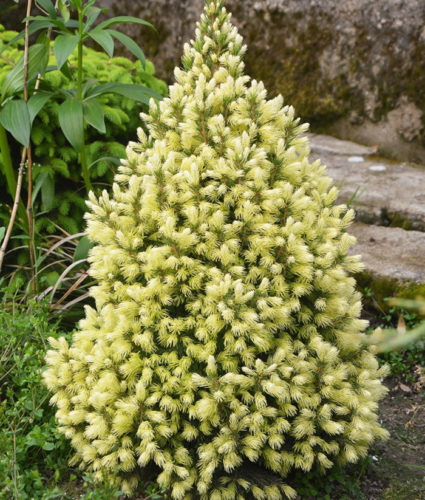
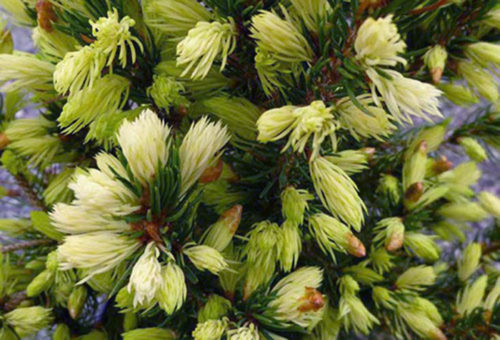
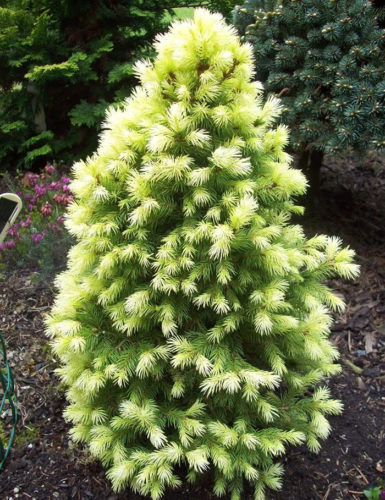

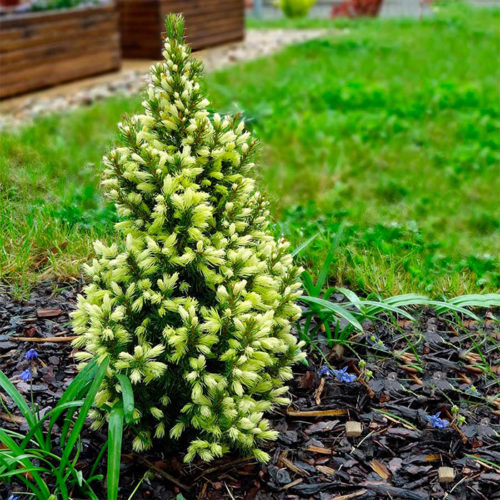
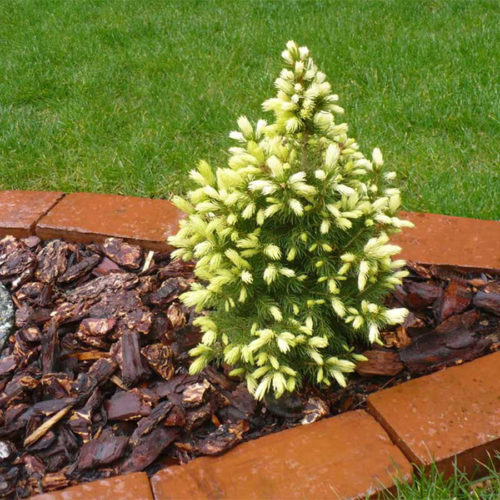
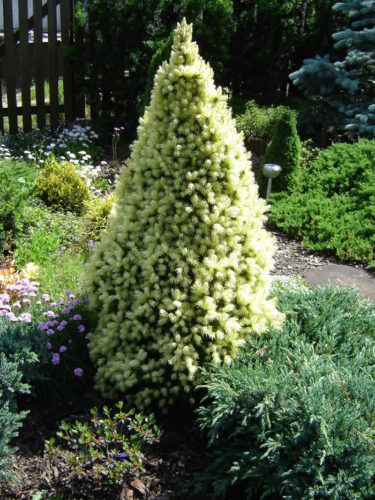
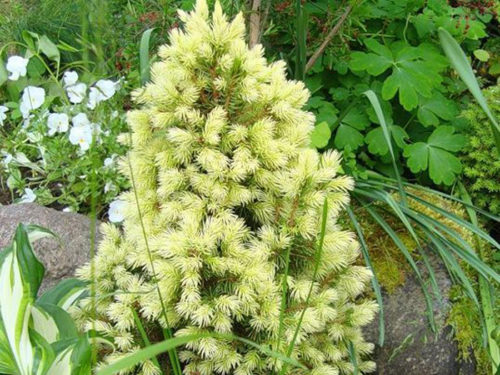
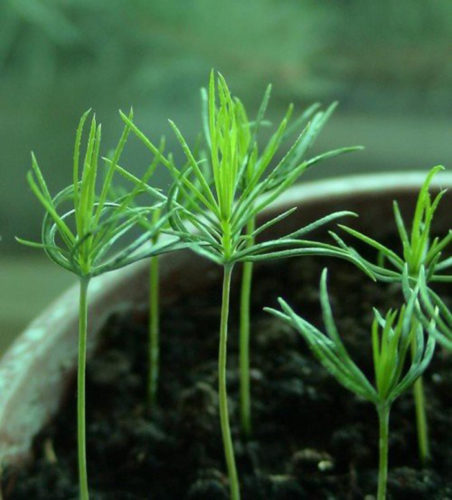
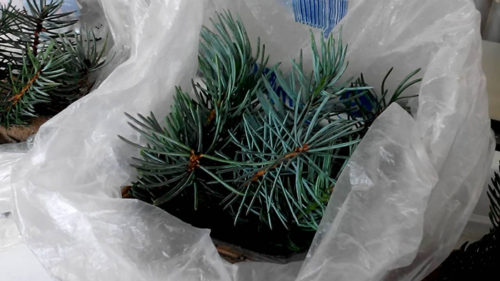
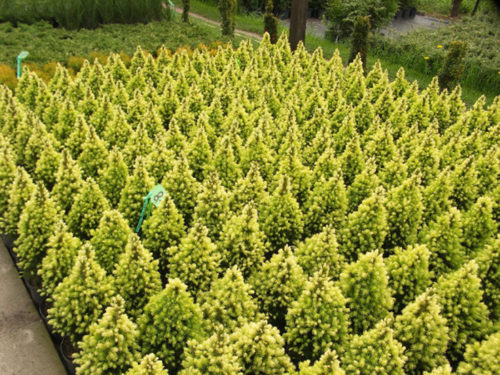
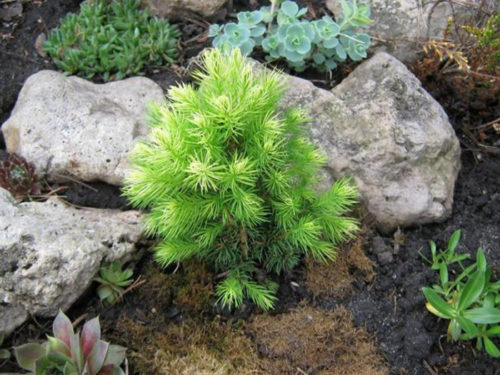
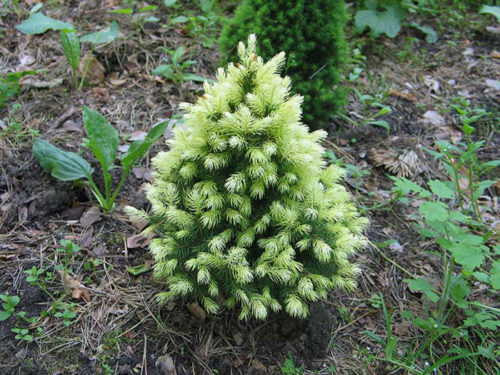












 Start a discussion ...
Start a discussion ...